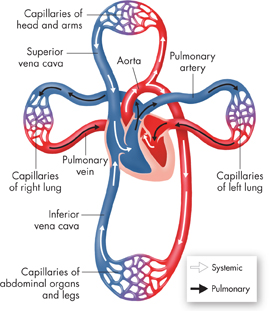Blood Flow Through the Heart Blood from the body enters the heart through the right atrium; blood from the lungs, through the left atrium. When the atria contract, blood flows into the ventricles. Flaps of connective tissue called valves are located between the atria and the ventricles. When blood moves from the atria into the ventricles, those valves open. When the ventricles contract, the valves close, preventing blood from flowing back into the atria. Valves are also located at the exits of each ventricle. This system of valves keeps blood moving through the heart in one direction, like traffic on a one-way street.
The Heart's Blood Supply Heart muscle needs a constant supply of oxygen and nutrients. Surprisingly, the heart gets very little oxygen and nutrients from the blood it pumps through its chambers. Instead, a pair of blood vessels called coronary arteries, which branch from the aorta and run through heart tissue, supply blood to the heart muscle. Coronary arteries and the vessels that branch from them are relatively narrow, considering the needs of the heart. If they are blocked, heart muscle cells run out of oxygen and could begin to die. This is what happens during a heart attack, which we discuss in Lesson 33.2.
MYSTERY CLUE

Why is the heart especially susceptible to a disease that narrows blood vessels?
Circulation Although it is one organ, the heart functions as two pumps. One pump pushes blood to the lungs, while the other pump pushes blood to the rest of the body, as shown in Figure 33–3. The two pathways of blood through the body are called pulmonary circulation and systemic circulation.
▸ Pulmonary Circulation The right side of the heart pumps oxygen-poor blood from the heart to the lungs through what is called pulmonary circulation. In the lungs, carbon dioxide diffuses from the blood, and oxygen is absorbed by the blood. Oxygen-rich blood then flows to the left side of the heart.
▸ Systemic Circulation The left side of the heart pumps oxygen-rich blood to the rest of the body through what is called systemic circulation. Cells absorb much of the oxygen and load the blood with carbon dioxide. This now oxygen-poor blood returns to the right side of the heart for another trip to the lungs to pick up oxygen.
 In Your Notebook Draw a cycle diagram that represents both pulmonary and systemic circulation.
In Your Notebook Draw a cycle diagram that represents both pulmonary and systemic circulation.

FIGURE 33–3 Circulation Pathways The circulatory system is divided into two pathways. Pulmonary circulation carries blood between the heart and the lungs. Systemic circulation carries blood between the heart and the rest of the body. Observe What kind of blood—oxygen-rich or oxygen-poor—leaves the lungs and returns to the heart?
dTable of Contents
- Formulas and Equations
- Applying Formulas and Equations
- Mean, Median, and Mode
- Estimation
- Using Measurements in Calculations
- Effects of Measurement Errors
- Accuracy
- Precision
- Comparing Accuracy and Precision
- Significant Figures
- Calculating With Significant Figures
- Scientific Notation
- Calculating With Scientific Notation
- Dimensional Analysis
- Applying Dimensional Analysis




